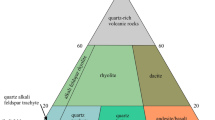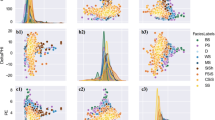Abstract
Automatic identification of rock thin sections provides valuable geological information for oil and gas exploration. However, the application of rock thin sections identification in new blocks works poorly. The reason is that the geological data of target blocks are extremely scarce in the early stage of exploration and development. Therefore, using an improved MaSE-ResNetXt network, data enhancement, feature extractors, online transfer learning and other strategies, a stable, efficient and continuously growing end-to-end identification system based on online transfer learning was built.
In case one, the use of the basic MaSE-ResNetXt network on regional rock properties and model categories was compared with previous studies and experiments, and performance improvements of 5% and 14.3% were achieved respectively, which verified the high efficiency of the basic MaSE-ResNetXt network for feature extraction in a large-scale dataset. In case two, sensitivity analysis was conducted for similar categories that are easily confused, during which parameters of the network and optimizer were compared. The sensitivity problems of oolitic structure feature maps were discussed and optimized. After that, a weighted F1-score of 0.95 was reached, proving the prediction stability of cross-regional transfer. In case three, real-time online transfer learning for the cold boot was conducted with scarce geological data. Compared with the previous studies, the training speed was improved by 15 times, and the accuracy was improved by 20%.
An improved method based on MaSE-ResNeXt with transfer learning using a neural network feature map for rock characteristics analysis was proposed. By proposing inheritance and real-time online transfer learning solutions, the problems of automatic rock thin sections identification in a new area were solved, and the geological data of multiple blocks were fully used. By doing so, this study bridged the gap that experiences from the former regions could not be inherited effectively for cross-regional rock thin sections identification, so that empowered the development of new blocks.
Similar content being viewed by others

Data availability
https://www.scidb.cn/en/detail?dataSetId=732953783604084736&language=null&dataSetType=journal
There are the interpretations in English in the Github repository.
References
Budennyy, S., Pachezhertsev, A., Bukharev, A., Erofeev, A., Mitrushkin, D., Belozerov, B., 2017. Image Processing and Machine Learning Approaches for Petrographic Thin Section Analysis. OnePetro. https://doi.org/10.2118/187885-MS
Caja, M.Á., Peña, A.C., Campos, J.R., García Diego, L., Tritlla, J., Bover-Arnal, T., Martín-Martín, J.D., 2019. Image Processing and Machine Learning Applied to Lithology Identification, Classification and Quantification of Thin Section Cutting Samples. OnePetro. https://doi.org/10.2118/196117-MS
Chai, H., 2020: A carbonate micrograph dataset of Feixianguan formation in northwestern margin of upper Y angtze. Science data Bank. https://doi.org/10.11922/sciencedb.j00001.00021
Chai, H., Xing, F., Gu, Q., Chen, X., Zhou, S.: A carbonate micrograph dataset of Feixianguan formation in northwestern margin of upper Y angtze. China Sci. Data. 5, 131–140 (2020)
He, K., Zhang, X., Ren, S., Sun, J., 2016. Deep residual learning for image recognition, in: Proceedings of the IEEE Conference on Computer Vision and Pattern Recognition. pp. 770–778.
Hinton, G.E., Osindero, S., Teh, Y.-W.: A fast learning algorithm for deep belief nets. Neural Comput. 18, 1527–1554 (2006). https://doi.org/10.1162/neco.2006.18.7.1527
Hu, J., Shen, L., Sun, G., 2018. Squeeze-and-excitation networks, in: Proceedings of the IEEE Conference on Computer Vision and Pattern Recognition. pp. 7132–7141. https://doi.org/10.48550/arXiv.1709.01507
Huang, G., Liu, Z., van der Maaten, L., Weinberger, K.Q., 2017: Densely connected convolutional networks, in: 30th Ieee conference on computer vision and pattern recognition (Cvpr 2017). Pp. 2261–2269. https://doi.org/10.1109/CVPR.2017.243
Ioffe, S., Szegedy, C., 2015. Batch normalization: Accelerating deep network training by reducing internal covariate shift, in: International Conference on Machine Learning. PMLR, pp. 448–456.
Lai, W., 2020a: A photomicrograph dataset of rocks for petrology teaching at Nanjing University. Science data Bank. https://doi.org/10.11922/sciencedb.j00001.00097
Lai, W., 2020b: Photomicrograph dataset of cretaceous siliciclastic rocks from Central-Northern Lhasa terrane, Tibet. Science data Bank. https://doi.org/10.11922/sciencedb.j00001.00021
Lai, W., Jiang, J., Qiu, J.: A photomicrograph dataset of rocks for petrology teaching at Nanjing University. China Sci. Data. 5, 26–38 (2020)
LeCun, Y., Bottou, L., Bengio, Y., Haffner, P.: Gradient-based learning applied to document recognition. Proc. IEEE. 86, 2278–2324 (1998)
Liang, X., Zhou, F., Liang, T., Su, H., Yuan, S., Li, Y.: Impacts of pore structure and wettability on distribution of residual fossil hydrogen energy after imbibition. Int. J. Hydrog. Energy. 45, 14779–14789 (2020a). https://doi.org/10.1016/j.ijhydene.2020.03.208
Liang, X., Zhou, F., Liang, T., Wang, C., Li, Y.: Experimental quantification of formation damage caused by the cross-linked gel in tight gas reservoirs. J. Nat. Gas Sci. Eng. 84, 103608 (2020b). https://doi.org/10.1016/j.jngse.2020.103608
Liang, X., Zhou, F., Liang, T., Wang, C., Wang, J., Yuan, S.: Impacts of low harm fracturing fluid on fossil hydrogen energy production in tight reservoirs. Int. J. Hydrog. Energy. 45, 21195–21204 (2020c). https://doi.org/10.1016/j.ijhydene.2020.06.011
de Lima, R.P., Duarte, D., Nicholson, C., Slatt, R., Marfurt, K.J.: Petrographic microfacies classification with deep convolutional neural networks. Comput. Geosci. 142, 104481 (2020). https://doi.org/10.1016/j.cageo.2020.104481
Ma, H., Han, G., Peng, L., Zhu, L., Shu, J.: Rock thin sections identification based on improved squeeze-and-excitation networks model. Comput. Geosci. 152, 104780 (2021)
Marmo, R., Amodio, S., Tagllaferri, R., Ferreri, V., Longo, G.: Textural identification of carbonate rocks by image processing and neural network: methodology proposal and examples. Comput. Geosci. 31, 649–659 (2005). https://doi.org/10.1016/j.cageo.2004.11.016
Mlynarczuk, M., Gorszczyk, A., Slipek, B.: The application of pattern recognition in the automatic classification of microscopic rock images. Comput. Geosci. 60, 126–133 (2013). https://doi.org/10.1016/j.cageo.2013.07.015
Pattnaik, S., Chen, S., Shao, W., Helba, A., 2020. Automating Microfacies Analysis of Petrographic Images. OnePetro. https://doi.org/10.30632/SPWLA-5074
Polat, Ö., Polat, A., Ekici, T.: Automatic classification of volcanic rocks from thin section images using transfer learning networks. Neural Comput. & Applic. 33, 1–10 (2021)
Purba, S.A., Garcia, A.P., Heidari, Z.: A new hierarchical method for rock classification using well-log-based rock fabric quantification. Petrophysics. 59, 720–734 (2018). https://doi.org/10.30632/PJV59N5-2018a10
Shu, L., McIsaac, K., Osinski, G.R., Francis, R.: Unsupervised feature learning for autonomous rock image classification. Comput. Geosci. 106, 10–17 (2017). https://doi.org/10.1016/j.cageo.2017.05.010
Simonyan, K., Zisserman, A., 2014. Very deep convolutional networks for large-scale image recognition. ArXiv Prepr. ArXiv14091556. https://doi.org/10.48550/arXiv.1409.1556
Singh, N., Singh, T.N., Tiwary, A., Sarkar, K.M.: Textural identification of basaltic rock mass using image processing and neural network. Comput. Geosci. 14, 301–310 (2010). https://doi.org/10.1007/s10596-009-9154-x
Szegedy, C., Liu, W., Jia, Y., Sermanet, P., Reed, S., Anguelov, D., Erhan, D., Vanhoucke, V., Rabinovich, A., 2015. Going deeper with convolutions, in: 2015 Ieee conference on computer vision and pattern recognition (Cvpr). Pp. 1–9. https://doi.org/10.1109/cvpr.2015.7298594
Tagliaferri, R., Longo, G., D’Argenio, B., Incoronato, A.: Introduction: neural networks for analysis of complex scientific data: astronomy and geosciences. Neural Netw. 16, 295–295 (2003). https://doi.org/10.1016/s0893-6080(03)00012-1
Zeiler, M.D., Fergus, R., 2014. Visualizing and understanding convolutional networks, in: European Conference on Computer Vision. Springer, pp. 818–833. https://doi.org/10.1007/978-3-319-10590-1_53
Acknowledgments
The authors would like to express their gratitude to the reviewers of China University of Petroleum - Beijing for their critical comments.
Code availability
Repository: https://github.com/mmmahhhhe/MaSeResNeXt
Author information
Authors and Affiliations
Corresponding author
Ethics declarations
Conflicts of interests
The authors declare that they have no known competing financial interests or personal relationships that could have appeared to influence the work reported in this paper.
Additional information
Rock thin sections identification for industrial applications.
Large-scale and multi-scale applicability under harsh conditions.
Improved Squeeze-and-Excitation Networks.
Fundamentals of transfer learning in petrology.
Publisher’s note
Springer Nature remains neutral with regard to jurisdictional claims in published maps and institutional affiliations.
Rights and permissions
Springer Nature or its licensor holds exclusive rights to this article under a publishing agreement with the author(s) or other rightsholder(s); author self-archiving of the accepted manuscript version of this article is solely governed by the terms of such publishing agreement and applicable law.
About this article
Cite this article
Wang, B., Han, G., Ma, H. et al. Rock thin sections identification under harsh conditions across regions based on online transfer method. Comput Geosci 26, 1425–1438 (2022). https://doi.org/10.1007/s10596-022-10174-2
Received:
Accepted:
Published:
Issue Date:
DOI: https://doi.org/10.1007/s10596-022-10174-2



